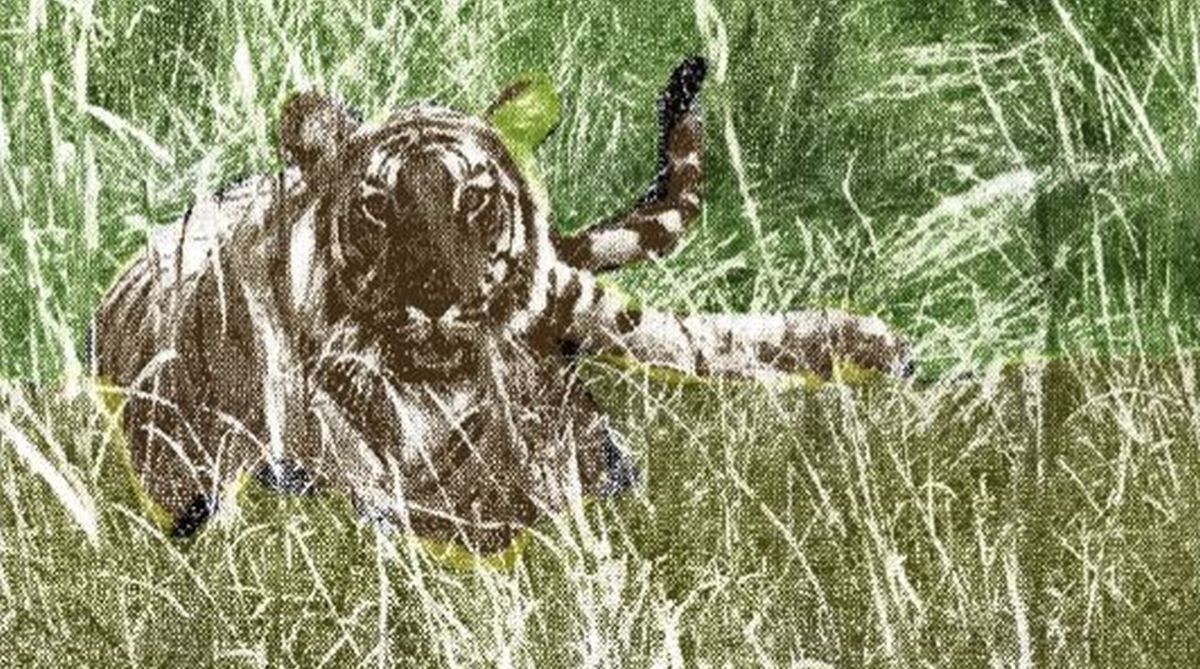Foresters on alert after trap cameras in Jhargram spot tiger
The tiger from Jharkhand had entered into a locality in the small hours today and its pugmarks were detected beside the cattle shed of a resident in Sarenga block in Bankura.
The old saying that two tigers cannot share a hill does not hold at Kanha National Park.

(Photo: SNS)
The tigers, naturally, attract the most attention at Kanha. They would, anywhere where they are so tolerant of humanity. I have no idea of what tigers here were like, say, a dozen years ago. Those likely to know, whom I asked, told me they were wild and wary then and much less diurnal, and that in this period they had gradually become accustomed to take the buffalo baits tied out for them, and in the process become remarkably tolerant not only of men, but also of one another.
The old saying that two tigers cannot share a hill does not hold at Kanha. The mahouts showed me a very large, round-faced tigress which they called “bade ma”, in the cover around Sehaller Tower. I saw her alleged daughter, an adult tigress with two cubs, in this same cover ~ this was a rather small and very beautifully built tigress with a distinctive colour and much “temperament” and her cubs, both male, were all most her size, but one of them was thin and weedy while the other was robust.
Advertisement
There was a highly nocturnal tiger, said to be the father of these cubs, visiting the neighbourhood in the darkness, and in a different patch of cover another tigress with a young cub ~ I did not see these, but heard about them from other and saw their pugs. Two or three miles further on there was another big tiger which, too, I did not see; his pugs, however, proclaimed his size. These were the tigers to be found around the lodges at the Kanha National Park in May 1968.
Advertisement
I was too preoccupied with the tigress and her two cubs (during the day the cubs were seldom with her and often not even near) to give myself a fair chance of seeing the other tigers of the area. The tigress was compact, very graceful in her movements, and light coloured. Her ground colour was remarkable for its sudden transition from a pale burnt sienna on the head, neck and shoulders to a much paler ochre, almost cream, on the body and hind quarters.
She was apt to resent being disturbed, or followed on elephant back, but by keeping my distance and moving in gradually, and the exercise of much self-control, I was able to get her to accept Madhuri, the mahout and me on several occasions ~ our elderly riding elephant. Madhuri, was fully 9- foot-3-inch high and massively proportioned, but her indifference to the proximity of the tigress helped much in getting really close.
One afternoon the tigress took us to a patch of tall grass in which her reputed mother was lyng up; she entered the cover and lay down only yards from the older, much darker and larger tigress, and for half an hour I watched them from about 30 yards away. They made small, untigerish whining noises, calling to each other very much in the manner of a chained dog trying to attract the attention of a man.
Moving in to get a nearer view, we disturbed the big tigress who left the cover. Such a pretty family picture, all this, but the mahouts at Kanha told me that this “bade ma” and her beautiful daughter had conspired to kill another tigress and her cub which had formerly been in possession of the territory. I concede that the tigers at Kanha are still truly wild, and that a study of their intra and extra-specific relationships would be quite reliable and, much more to the point, easily feasible her as it is not elsewhere.
Such studies are of undoubted value, and tell us much about the ways of wild tigers as studies of captive tigers do not. To take only one example, no one who has watched tigers at Kanha can fail to be impressed by their somewhat dog-like habit of marking tree trunks and other uprights with their urine, to serve as secnt posts.
Those who have tried the experiment say that tigers are unable to locate their kill on a second visit, if the kill is moved by scent, even though the remains may be so smelly that even men can smell them. And it is well known that tigers hunt entirely by sight and hearing, and make no use of their noses to locate prey. If may seem surprising therefore, to find them marking territory and/or their movements, by means of scent.
Actually, there is no cause for surprise in this. Territory and movements cannot, obviously be flagged by visible or audible means, and although we ourselves are dreadfully near-scented, we are apt to presume that the scenting powers of all animals are exquisite and farreaching, because some animals go mainly by airborne scents.
Nor do we make adequate allowance for the great differences that exist among animals in their scent perceptions. Tigers, evidently, are near-scented and their acrid-smelling urine probably holds its scent for quite a long time.
No doubt all this is true, but it is no less true that there are tigers in most other parts of India besides Kanha, and that in them they are apt to be very intolerant of one another and very shy of men, and to wander over a much wider circuit than at Kanha.
This was published on 6 April 1969.
Advertisement